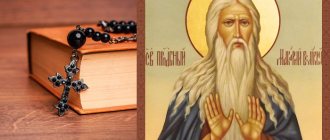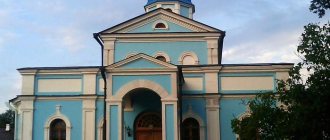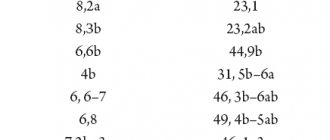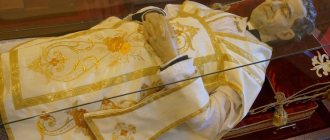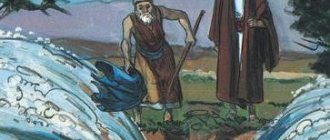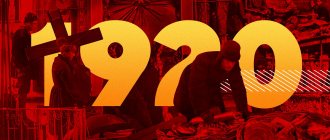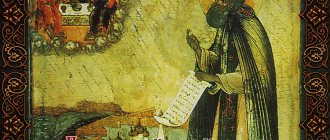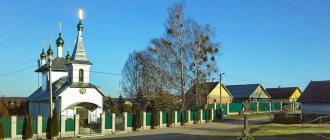Venerable Macarius of Kalyazinsky, abbot
Life of St. Macarius of Kalyazin
“I worked in vain and without success made such a long journey to the Holy Mountain past the Kalyazin Monastery.
For those who live in it can also be saved: here everything is done like the monasteries located in the Holy Mountain,” this was the review of this famous Russian monastery, located on the Volga within the boundaries of Tver, by Elder Mitrofan (Byvaltsev), who labored for nine years on Mount Athos. The decorum and splendor of the monastery was also noted by the Monk Joseph of Volotsky, the famous preacher and strict abbot of the famous monastery on Volok Lamsky, a famous fighter against the heresy of the Judaizers. From all over Rus', thousands of pilgrims went to Kalyazin in order to witness with their own eyes the deeds of the brethren and venerate the honorable relics of the founder of that monastery - St. Macarius of Kalyazin, to receive relief and healing from serious mental and physical ailments. And here, at the shrine with the holy relics, many miracles were performed by the faith of those who came. The Monk Macarius, abbot of the Trinity Kalyazin Monastery, was born in 1402, in the village of Gridtsin (Gribkovo, now Kozhino), near Kashin, into a God-loving family that strictly respected the commandments of the Lord. Parents, boyar Vasily Ananievich Kozha, famous for his military exploits under Grand Duke Vasily Vasilyevich II the Dark, and his wife Irina (their memory is revered locally) raised Matthew (name in the world) from childhood in faith and reverence for God. The youth loved to spend time reading spiritual books, and everything he read sank deeply into his heart. He was not carried away by games and in his soul he constantly offered up prayers, psalms and spiritual songs dear to his heart, while thinking about how to serve God.
When he began to reach adulthood, Matthew began to think about moving away from the vain worldly life; his parents, however, did not want him to become a monk, and cited biblical examples of the lives of New Testament saints who were saved in the world. The obedient son, not wanting to upset his family and obeying, agreed to the marriage and soon married the girl Elena Yakhontova. The young couple promised each other that if one of them died, the widowed one would become a monk. A year after the wedding, Matthew lost his father and mother, and two years later, Elena died; and twenty-five-year-old Matthew left the temporary, seeking the eternal, and entered the nearby Nikolaev Klobukov Monastery, where he took monastic vows with the name Macarius.
He went through all the monastic obediences with zeal, surpassing everyone else in humility and meekness, and the exploits of the young monk aroused the surprise of the brethren. After some time, burdened by the crowds of the monastery, the monk, with the blessing of the abbot, retired into the desert. He chose a place in the forest, located 18 versts from Kashin, not far from the Volga, between two small lakes. Here he cut down his cell, and no one interfered with his feat of solitary prayer, only wild animals came and caressed him, and he shared food with them. Having learned about the hermit, monks began to flock to the Monk Macarius, wanting to pray with the monk in his cell. He humbly received them and instructed them in the rules of monastic life. So the secluded forest thicket turned into a monastery, where the Monk Macarius was elected abbot.
The land on which the brethren lived belonged to the boyar Ivan Kolyaga, who, from the time the Monk Macarius settled there, looked at the monk with hostility. When the church was built and the number of hermits increased, Kolyaga was afraid that part of his land might go to the monastery; and this depressed him so much that he even planned to kill the saint... But God’s punishment was not slow to tell: death befell Kolyaga’s family, and he himself became seriously ill. Being in misfortune, the boyar who had made evil plans repented of his sin and, having confessed it to Macarius, was forgiven.
Soon Kolyaga, under the influence of the saint’s sermon, entered the Makariev Monastery, donating all his lands to him. Since then, for the sake of humility, Macarius himself called the monastery Kalyazinskaya (now the city of Kalyazin, Tver province). Quite quickly it became widely known, for the disciples of St. Macarius, following the example of their spiritual father and mentor, improved in monastic feat and maintained strict asceticism. Many people - both nobles and commoners - asked the monk to accept them into the ranks of the brethren. And, it must be said, even during the life of St. Macarius, St. Ephraim of Perekom (May 16) and St. Paisius of Uglich (June 6) left the Kalyazin monastery.
Miraculous was the prayer of the Monk Macarius, who during his lifetime received from God the gift of healing the sick and suffering. Thus, he freed a certain paralytic Zacharias from the village of Kesova Gora from illness, admonishing him with love: “Child! The Most Good God does not want the death of the sinner, but life and conversion to salvation, and what destinies He knows, leads him to salvation through repentance. You have been visited by God and if you repent and leave your old customs, God will send you healing; if not, then you will suffer even more than this.” The sinner who repented was healed, and after that he became a priest in his village and remembered the instructions of the Monk Macarius all his life.
Another time, the monk cured the boyar Vasily Ryasin, who was tormented by demons. After the prayer, the Monk Macarius made the sign of the cross over him, and he was cleansed. Delighted by the mercy of God sent down, he chose the monastic path.
The Lord also rewarded the spirit-bearing elder with the gift of clairvoyance. One day the monastery's oxen were stolen. Suddenly the thieves were struck by blindness and, after wandering for a long time in the surrounding area, they again found themselves at the gates of the monastery. The Monk Macarius was inspecting the farm at that time and, as if not knowing what was the matter, asked, when he saw them, why they were here, and besides, with oxen. The kidnappers confessed everything and repented. The monk forgave them their sin and, having healed them, ordered them not to encroach on someone else’s property in the future.
Shortly before his death, the Monk Macarius fell ill. For some time he was silent, and in anticipation of the outcome, calling the brethren, he blessed and kissed everyone and said goodbye: “I hand you over to the Lord God! Always remain in labor, fasting, vigil and unceasing prayer; Maintain spiritual and physical purity, do not repay evil for evil or annoyance for annoyance. Understand, brethren: if I have boldness towards God, then after my departure this monastery will not become scarce, but will expand.”
Hegumen Kalyazinsky reposed on March 17, 1483, a very old man, in the 82nd year of his life, and was buried near the wooden church he built. A wooden chapel was built and decorated with images over his grave. When the temple fell into disrepair, the donors decided to renovate it by building a stone church on the site. While digging ditches for its foundation, the saint's coffin was found. A fragrance emanated from his incorruptible relics, the old man’s gray hair was clean, and even his vestments had not changed. This happened on May 26, 1521.
Many healings of the paralytic, the demon-possessed, and those suffering from bone pain, blindness, and leg disease took place at the relics of the saint. This attracted many pilgrims to the monastery. Until 1547, St. Macarius was revered locally. Miracles and popular love contributed to the fact that at the Moscow Council of 1547 he was canonized as a saint of God and it was decided to celebrate his memory throughout Russia. Ordinary people went to Kalyazin on foot, kings visited the monastery: in 1553, Tsar Ivan Vasilyevich the Terrible visited the monastery, in 1599, Boris Godunov with his wife and children arrived to ask the Monk Macarius for a blessing for his daughter Ksenia to marry. Then the royal pilgrims built a silver shrine, into which the holy relics of the saint were transferred.
In 1610, the monastery was plundered by the Poles, many of the brethren were killed. After the Time of Troubles, the rulers of the new ruling house of the Romanovs also prayed in it several times: in 1619, Tsar Mikhail Fedorovich, in 1635, his father, Patriarch Filaret. In 1654, during a pestilence, Tsarina Maria Ilyinichna and Patriarch Nikon resided in the Kalyazin monastery. In 1700, pious donors built a new silver shrine for the relics, in which the saint of God rested until the closure of the monastery by Soviet power. After its plunder in the 1930s, the relics were transported to Tver, to the White Trinity Cathedral. In 2012, the relics of St. Macarius were solemnly transferred to his homeland in the city of Kalyazin, to the Church of the Ascension of the Lord.
The memory of the Monk Macarius, the Kalyazin wonderworker, is celebrated on March 17/30, the day of his death, and on May 26/June 8, the day of the discovery of holy relics, when a procession of the cross takes place in Kalyazin with a huge crowd of pilgrims. The Makariev Monastery also celebrated the saint’s name day – November 16/29.
Saint Macarius is also venerated in the Cathedral of Tver Saints (movable celebration on the first Sunday after June 29/July 12 - the day of the holy supreme apostles Peter and Paul).
Discovery of the relics of St. Macarius of Kalyazin
The discovery of the relics of St. Macarius of Kalyazin took place on May 26, 1521. A merchant from the city of Dmitrov, Mikhail Voronkov, donated funds for the construction of a stone church instead of a dilapidated wooden one in the Kalyazinsky monastery. The abbot of the monastery, Joasaph, erected a cross in the place intended for the altar, and blessed the digging of ditches for the foundation. During the work, an undestroyed coffin was found, from which a fragrance emanated. Hegumen Joasaph immediately recognized the coffin of the founder of the monastery - the Monk Macarius, who reposed in 1483. The brethren of the monastery and many of the gathered people performed a memorial service over the coffin that was transferred to the church. From that day on, healings began to take place at the incorruptible relics of the saint. This was reported to Moscow Metropolitan Daniel (1522–1539), who convened a Council in Moscow and, having examined in detail the evidence of the holiness of St. Macarius, established a celebration for the newly-minted saint. The relics were solemnly transferred to the temple in the Name of the Holy Trinity. Theodosius from Tver compiled a service for the discovery of the relics. Until 1547, veneration of Saint Macarius was performed only in his monastery. At the Moscow Council of 1547, under Metropolitan Macarius (1543–1564), the Monk Macarius of Kalyazin was canonized, and his memory, along with other Russian saints, was decreed to be celebrated throughout Russia.
See also: “ The Life of our Venerable Father Macarius of Kolyazin” as presented Demetrius of Rostov.
Program of celebrations and their historical basis
On June 6, the Divine Liturgy will begin, which will take place in the Alekseevsky Church of the Nikolaevsky Klobukov Convent in Kashin. It was in this monastery that Macarius Kalyazinsky took monastic vows. After the liturgy, guests of the holiday will be able to take part in a procession to the Church of the Ascension of the Lord in Kalyazin, where Vespers with an akathist will be held in front of the relics of Macarius of Kalyazin. On June 7, an excursion to the bell tower of the Nikolsky Monastery is planned. And in the evening there will be an all-night vigil in the Church of the Ascension of the Lord. On the morning of June 8, a divine liturgy is planned on the square in front of this church.
Macarius of Kalyazinsky left the Nikolaev Klobukov Monastery in 1434, along with a handful of students. They founded a monastery in the name of the Holy Trinity in the deep forests near Kashin. Subsequently, the city of Kalyazin grew here. The monastery itself existed for almost 500 years. It was closed in 1920, and at the end of the 30s of the last century it was dismantled before the territory was flooded with the waters of the Uglich Reservoir. Frescoes and inventory are stored in the Museum of Architecture of the Russian Federation and in the Tver Regional United Museum.
In March 2022, the leadership of the Kalyazinsky district and Metropolitan Ambrose of Tver and Kashin agreed to transfer the island on which the Trinity Monastery was located to the Tver diocese for free use for at least 10 years. They plan to restore the monastery.
The procession of the cross in June 2022 will take place along historical places and paths that the Monk Macarius and his disciples could have followed.
— The Upper Volga region is a territory that has enormous cultural and historical significance. Kalyazin, Kashin and other cities of the Tver region are not just historical centers of the past, they are custodians of a great heritage,” says Igor Rudenya.
